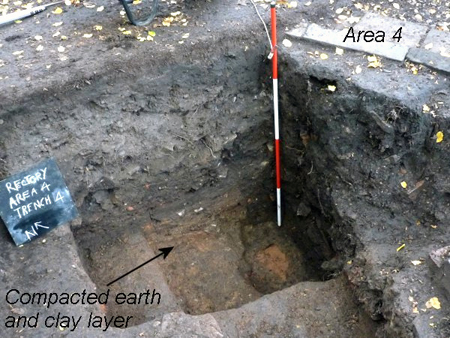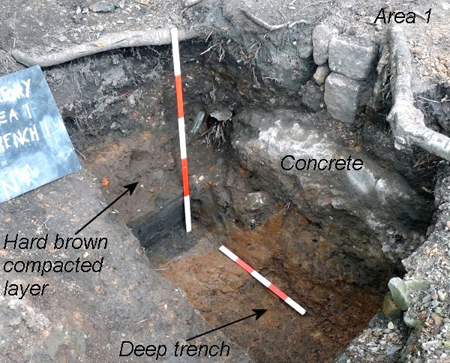|

After a short lay off over the winter months we are now back work at the Rectory (just Sundays as before).
Area 4. At the end of last year we had ended up with quite a deep trench on this site (which is located in the far east corner of the grounds). We were hoping to find evidence of the old Frog Lane, as shown on early maps. The 1849 map shows it continuing beyond the entrance to the hall leading to what could have been the original entrance. The area has suffered from much disturbance, particularly during the period just before the construction of the present hall. We did, however, discover a number of interesting features. These include three hard surfaces at different levels, the earliest possibly dating to the 17th century. Trench restrictions prevented us from indentifying the extent of the features and therefore whether they represented roads surfaces or not. The lowest however consists of compacted earth and clay, 40cm thick and is reminiscent of the compacted bank we had discovered in the Area 1 (could this be the defensive bank described by Sibson?). Unfortunately we have had to curtail our activities in this trench as it lies very close to a mature hornbeam. A tree health specialist, employed by the landowner, has become concerned about this and so we have completely backfilled this trench now.

Area 1. We've started backfilling the trenches here too. However before finishing off on this site (which is located on the left of the entrance) we decided to take a look at some of the unanswered questions surrounding the large concrete feature we discovered in 2010 (Newsletter No.139).
Firstly, did the large iron pipe discovered under the track on its south edge, continue under the concrete? We proved that it did with a small test pit at the interface between the track and the concrete. Secondly, did the deep trench cutting through the dirt track on the north side, also continue under the concrete? Again an excavation at the interface proved that this was the case. This puts its construction sometime between the track and concrete (however we still don't know what it was for). As we investigated this feature we came across the same thick band of hard brown compacted material that we first detected lying under the water feature on the northwest side of the trench. The layer is full of 17th/18th century pottery, bits of iron and large pieces of cow bone. However what is particularly exciting is that underneath this is a layer cutting into the natural which is filled with a soft dark bluey grey material - the type of material usually resulting from stagnant water. Could this, at last, be the moat we have been looking for. It is early days and we will have difficulties extending this trench because of the trees and the banked terrace on this side of the trench (however it is not impossible). More details as usual on our Forum (Area 1 and Area 4).
Wigan History Day
To coincide with the Civil War Day being held in Wigan on Saturday 26th May, Wigan Parish Church are holding a History Day. It will be an exhibition covering all times of Wigan's history and will be filled with exhibits of all kinds illustrating the town's long and varied past. It will be an opportunity to increase the awareness of our town's history and the various organisations that care for it. It will also provide an insight into the future plans for the restoration of parts of the church. Our Society will have a stand which will enable us to show off some of the projects and activities we have been involved in over the years. Entrance is free and the exhibition will run from 9.00am to 4.30pm.
Next Meeting
Wednesday 2nd May - at our new venue, the Standish Suit at the Brocket Arms (7.30pm as usual). Parking is still proving to be a bit of an issue but most people seemed to be able to find somewhere last time. This month we have our chairman, Eric Walter, whose talk is entitled 'An Assessment of the Archaeology of Jerusalem'. Eric has been studying this subject for many years and has put together a fascinating presentation. Hope to see you there, - BA
|



